Cloud Computing for Business : Establishing your Cloud Vision
Your business situation is either a problem or an opportunity for which you are seeking a solution that includes IT enablement. You see a technological possibility – such as cloud computing – as the way to solve your problem, or seize your opportunity. This is your architecture vision.
An IT architecture vision shows how a business need can be met, or opportunity realized, by a particular combination of technology capabilities. It provides the sponsor with a key tool to sell the benefits of a proposed project to stakeholders and decision-makers within the enterprise, or to external investors.
Case 5: People Productivity, Workplace Collaboration in Cloud Computing in Use sets forth a vision: “We will improve communication within and outside the organization by using cloud-based collaboration tools.” For Case 7: Business Transaction Assurance and Continuity, the vision is: “We will ensure that our business can continue in the face of disruption or disaster by using back-up resources on the cloud.” Each of the business use-cases in that appendix encapsulates an architecture vision that has cloud computing as its technological basis.
This chapter describes how to establish such a vision. It discusses how to assess your business context, and determine whether cloud computing will help you reach your goals. This discussion is illustrated by three examples, which are introduced here and will be used throughout the rest of the book.
This Guide is concerned with IT solutions that are solutions to business problems, and that use cloud services. A complex solution of this kind should not be built ; it should have a properly thought-through architecture. An architecture vision is the starting point for the development of such a solution architecture.
For the enterprise as a whole, an overall enterprise architecture will define roadmaps for the development and deployment of solutions. While cloud computing may not be the basis of your enterprise architecture, you should consider it as a significant component, and develop a cloud roadmap to ensure that cloud computing is incorporated in your solutions in a sensible and co-ordinated fashion.
This Guide does not address the further process of developing enterprise or solution architectures. Refer to The Open Group Architecture Framework [TOGAF] for more information on architecture development.
Understanding the Business Context
When looking at the technological possibilities, you must fully understand the business context. This section discusses the aspects of your business context that affect the decision to use cloud computing.
Basic Situation
Consider the size of your enterprise, the industry sectors in which it operates, its geographical distribution and locations, and legislation and other external regulation that applies to your business.
Business Goals
What are the business goals you seek to address?
As described in the previous chapter (Chapter 2), you might be looking to improve your agility, improve your productivity, improve the quality of your IT, improve your cost model, or take advantage of new business opportunities.
You should analyze and describe your business goals as the starting point of your understanding of your business context.
Risk-Reward Balance
What is the acceptable risk-reward balance?
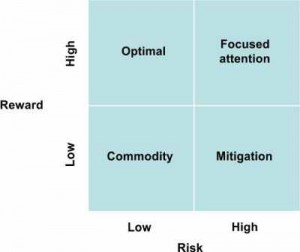
For low risk, consider whether low-risk activities can be moved to an on-demand service environment, and whether activities can be identified to explore and exploit on-demand business opportunities with mitigated risk management through partnerships and risk sharing with cloud services.
For high risk, consider:
- What business process operations carry high corporate risk in operational and legal failure
- Whether high corporate risk can be mitigated further by enhanced risk sharing and disaster recovery and business continuity practices supported by on-demand back-up and recovery services
- Whether there are specific corporate risks that can be linked to specific IT software applications, infrastructure, and services
- Whether corporate benefits should be traded-off against corporate risks
For low reward, consider whether business activities with low corporate return can be commoditized for low-cost competitive advantages.
For high reward, consider whether there are opportunities to improve market share, revenue, profit, or cost management through on-demand delivery of cloud services.
Impact on Products and Services
Does the business seek to explore new products and services in new markets (transformative and disruptive), or to exploit existing markets with current products and services (utility and commodity)? This positioning is a key aspect of business strategy and delivery.
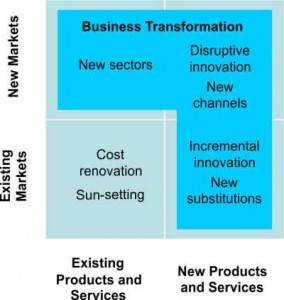
Existing products and services can be offered through on-demand self-service, augmented and enhanced through on-demand features and options, or commoditized for competitive low-cost advantages.
New products and services can be sourced and delivered on-demand. They can be disruptive to existing products and services through superior cost and functional performance, or offered as commodities for competitive low-cost advantages.
New and existing markets can be expanded through rapid scaling and expansion of products and services offered, or entered by offering commodity products and services for competitive low-cost advantages.
Business Processes
Which business processes are under consideration?
You may be considering:
- Your complete business process portfolio
- No specific business processes
- One or more specific processes
- The processes in one or more specific business areas
You should identify the specific processes or specific process areas. Example business areas and activities carried out by business processes are shown in the table below.
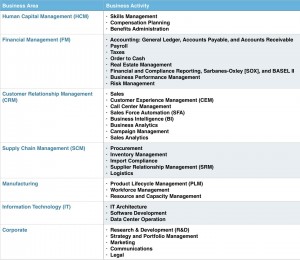
Consider whether these business processes are differentiating, part of your company’s competitive advantage. Differentiating business processes are the only processes for which a case for in-house, custom, dedicated enablement independent of the rest of the business portfolio can readily be made.
For non-differentiating, “business-as-usual” processes, such as benefits, inventory, accounting, and intellectual property management, you should seek to minimize Total Cost of Ownership (TCO), while maintaining functionality and Quality of Service (QoS). For non-differentiating processes concerned with external compliance, such as SOX II compliance, ethical procurement, and carbon footprint management, you should seek to achieve timely delivery of functionality, to meet QoS requirements, and to minimize TCO.
If your processes are part of your competitive advantage, consider whether the differentiation is based on IT capabilities. An example is information retrieval supported by an Internet search engine. In such a case, you should seek to align with corporate mission and strategic objectives, and erect barriers such as intellectual property protection to prevent imitation. If the IT is not a differentiating factor, as for example with online sales and store returns, you should seek to meet functional and QoS requirements, and adapt quickly to changes in those requirements.
Consider how far the IT resources used by the business processes are dedicated and customized. IT resources include software applications, IT infrastructure, and development and support personnel. They may be fully dedicated to the processes under consideration, partially dedicated, or fully shared. They may be customized, tailored, or standard.
Consider also the degree of dedication and customization of the non-IT resources used by the processes. These include labor, fixed assets, and process definitions.
Scope and Complexity
What is the scope of operation relative to the process complexity?
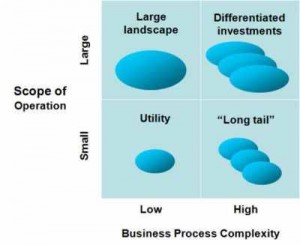
For a small scope of operation, consider what niche business process operations could be moved to an on-demand hosting provider, whether specific IT operations can be moved to an on-demand hosting provider, and whether specific IT operations can be commoditized for competitive low-cost advantages.
For a large scope of operation, consider what scope of existing business operation can be moved to an on-demand hosting provider, and whether a large scope of existing IT landscape can be moved to an on-demand model.
For low business process complexity, consider whether low-complexity business processes can be commoditized for low-cost competitive advantages.
For high business process complexity, consider what specific business processes need to be retained under control of the business for competitive advantage, and whether highly complex business processes can be improved through complexity reduction.
Collaboration versus Information Restriction
What is the balance between collaboration and the need to restrict information?
You should understand the degree of collaboration and types of data that can be moved into a cloud environment, and assess the different cloud deployment and hosting models that meet their sovereign, corporate, and personal security and collaboration needs.
The degree of collaboration can range from individual working to integrated community activity. The information involved can be private to the individual or community, or can be public.
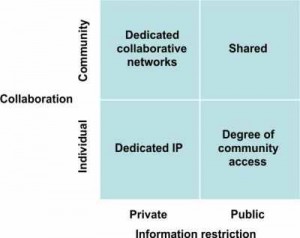
For individual operation, consider whether desktop and mobile working can be improved through on-demand personal productivity tools (such as email, bulletin boards, and office applications), and whether the personal information and assets created by individuals are the private intellectual property of the corporation, or can be shared.
For community collaboration, consider whether business participants and stakeholders can collaborate in a shared platform and business service environment, and whether the information and assets created by collaboration are the private intellectual property of the corporation or collaborating group, or can be shared.
For private information, consider whether current corporate and personal data rules identify and define who owns what intellectual property, and whether corporate and personal data can be partitioned and isolated effectively for secure storage and access control.
For public information, consider whether:
- Current corporate and personal data rules prohibit the storage and access to personal and corporate information in public locations
- Legislation (such as EC Data Protection legislation or the US Patriot Act) affects personal and private data held in public locations
- Information held publicly can be monitored and managed to e-Discovery standards for legal purposes
- Personal and corporate information can be selected, partitioned, and isolated effectively for storage and use in public locations
Three Example Cloud Projects
In the rest of this Guide, we will use three fictional companies as examples to illustrate the ideas and bring the explanations to life. The descriptions of them are simpler than you might expect for a real-life company: this makes it easier to bring out the key points without being confused by extraneous detail. They are chosen to show different aspects of cloud computing. They are loosely based on the use-cases described in Cloud Computing in Use, but do not correspond to particular cases. The authors apologize if any real company is offended by any accidental resemblance.
Konsort-Prinz
This is a mid-sized European company that sells seasonal novelties by mail order. It started in the 1950s with Christmas decorations, and has since developed products for other festivals of various kinds, but the bulk of its business is still in December, with a few regular high spots during the rest of the year, and occasional, unpredictable “one-offs” (such as royal weddings). Everything it sells is bought from small manufacturers; it produces nothing itself. It uses in-house IT for its website and for order-processing, supplier management, and stock management. This is substantially under-utilized for much of the time, and Konsort-Prinz considers using cloud computing to reduce its capital costs and obtain a better return on its investment.
This company:
- Is looking to scale its IT resources appropriately
- Is looking to obtain a good reward, but at a low risk
- Will just offer its existing products and services, and in its current markets
- Is considering cloud for its website and for order processing, supplier management, and stock management primarily (but could also use it for other business processes)
- Is looking at a large scope of operation and process complexity
- Has some collaboration with suppliers, but will keep information private within that community
Sam Pan Engineering
This is a large conglomerate headquartered in Hong Kong and spread over South-East Asia and Australasia. It has a range of operations, from making small pleasure-yachts to installing water-purification equipment and air conditioning. It has factories and offices in many cities in several different countries. At present, most of these have some kind of IT capability, but this is very inefficient, and the company has decided to establish area data centers that will offer IT capabilities to the scattered locations. It believes that it could implement this as a private cloud.
This company:
- Is looking to cut costs and streamline business operations
- Is looking to obtain a good reward, and is willing to take some risk
- Will just offer its existing products and services, and in its current markets
- Is considering cloud for its complete business process portfolio
- Is looking at a large scope of operation and process complexity
- Wants to improve collaboration between its component companies, and for them to share information (but not for that information to go outside the corporation)
ViWi
ViWi is a small start-up company based in California that was formed to develop and sell the product that is its founder’s dream – the Virtual Widget. This is an intelligent agent operating on the Internet that people can use to do all sorts of wonderful things. (We don’t need to go into details of what these are.) The product will be developed on the cloud, and offered to the public as a cloud service.
This company:
- Wants to make big profits from an innovative product
- Is looking to obtain a high reward, and is willing to take a big risk
- Will offer a new product, in a new market
- Is considering the cloud for software development, and as the platform for its product
- Is looking at a large scope of operation but small process complexity
- Intends its virtual widgets as personal devices, but with ability to share some information publicly
Assessing Cloud Suitability – The Cloud Buyer’s Decision Tree
Cloud computing can bring business benefits to many enterprises. It is, however, not always the right solution, and there are several forms of cloud computing, which have different advantages in different situations.
Is cloud computing right for you? If it is, should you be considering IaaS, PaaS, or SaaS? Should you use public, private, community, or hybrid cloud?
If cloud computing is not right for you, should you consider alternatives? Alternatives that have some of the benefits of cloud computing include:
- Outsourcing all or part of your IT systems management or applications management – you could, for example, outsource data centers, IT management, governance, middleware, or data storage
- Business Process Outsourcing (BPO)
- Using hardware appliances
- Using virtualization
Outsourcing (including BPO) can deliver some of the commercial and organizational benefits of cloud computing, including reduced capital expenditure (CAPEX) and access to large pools of expertise for specialist tasks. Hardware appliances and virtualization can deliver some of the technical benefits, including the ability to deploy additional resources when needed, and more effective resource utilization.
This section presents a decision tree that helps you to determine whether cloud computing belongs in your vision. It makes the connection between the business use and the enabling cloud technology.
It is an aid to decision-making, not a definitive algorithm. Further considerations, either for or against a cloud solution, may emerge when you develop a detailed architecture.
Assessment Considerations
There are ten key questions, whose answers will help you to determine whether to use cloud computing, whether a public or private cloud is appropriate, and whether IaaS, PaaS, or SaaS cloud offerings would best meet your business and technical requirements. They are shown as a complete set in the figure below.
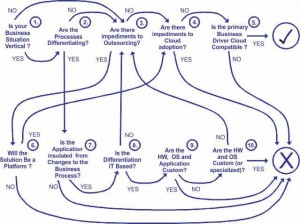
They are presented as a simple sequence. Your decision process may be more complex and iterative. Answering a question may require you to explore aspects of your business that you had not previously considered, and perhaps to re-evaluate your objectives for using cloud computing. You may find that you need to go back to a question that you answered previously, and re-consider your answer in the light of your later ideas. But thinking about these questions, in the order presented here, will help you to organize your consideration of cloud computing, and lead you to a better solution for your enterprise.
Question 1: Is your Business Situation Vertical?
Is your business scope a vertical or horizontal business process in the industry domain of operation?

Question 2: Are the Processes Differentiating?
Is the business process a key differentiator for the business? Are the business drivers and performance of this process critical to the competitiveness and cost-effective operation of the enterprise?

Question 3: Are there Impediments to Outsourcing?
Are there any barriers that may prevent some or all of the layers of the solution from being outsourced?
Common impediments to outsourcing include:
- Specification of in-house service cannot be matched externally
- Labor contracts
- Long-term leases
- Switching costs
- Fixed assets with depreciation value
- Immature business architecture
- Business culture
- Geographic location sovereignty rules
- Industry regulation
- Compliance audit rules
- Community relations

Question 4: Are there Impediments to Cloud Adoption?
Are there barriers to cloud adoption because of issues in hosting the service in a cloud environment that may be detrimental to the business drivers and ROI goals?
Most of the impediments to be considered for outsourcing apply also to cloud adoption. Only additional constraints specific to cloud are listed in this section.
Typical barriers include:
- Custom resources, no major changes planned
- Standard resources, but not adaptable to one-to-many; transformation not practical
- Policy restrictions on resource sharing or on control of configuration changes
- Flat requirements profile, no fractional resources
- Too few potential subscribers (not attractive market to providers)
- Entry costs too high
- SLA performance is not acceptable
- The Recovery Point Objective (RPO) and Recovery Time Objective (RTO) performance is not acceptable
These impediments can apply to SaaS, Paas, or IaaS, and to public, private, community, or hybrid cloud solutions.

Question 5: Is the Primary Business Driver Cloud-Compatible?
Though there may not be any operational barriers to cloud adoption, if the business objectives are not aligned with the inherent strengths and characteristics of cloud solutions, then non-cloud solutions will be a better fit for the business situation.
Cloud-compatible business drivers may include:
- Reduce medium and/or long-term TCO
- Improve cash flow
- Shift from CAPEX to OPEX
- Improve QoS or SLAs
- Access to functionality or domain expertise
- Scale labor or fixed asset capacity up or down
- Become a cloud provider
Cloud-incompatible business drivers may include:
- Cut short-term costs
- Shift from OPEX to CAPEX (public cloud incompatible)
- Increase capacity without need for third-party financing
- Change tax situation (recognize depreciation, job creation incentives, etc.)
- Shift fixed assets (potentially including leases) or labor to provider

If you determine that cloud computing is a good fit, you should review the following solution considerations.
You should consider all forms of cloud computing if:
- The business process is not a key differentiator for your business.
- The differentiation is not IT-based and the applications are insulated from changes to the business process.
- You have standard hardware, operating system, and applications.
If the business process is a key differentiator for your business, and the differentiation is IT-based, then PaaS or IaaS may fit, and:
- If you have standard hardware and operating system, and custom applications, then SaaS is unlikely to meet your needs.
- If the business process definition is de-coupled from the application, consider SaaS.
- If the business process definition is not de-coupled from the application, is it time to overhaul the business process, and could the definition be abstracted during that overhaul? If yes, then consider SaaS; if no, then SaaS is not for you.
For example, an SaaS or IaaS solution could be appropriate for a differentiating, IT-supported – or possibly even IT-based – business process if the differentiation is commoditization. There is a well-known PC supplier whose supply chain processes differentiate it from other suppliers. That differentiation is primarily due to the leverage that it has over its suppliers due to the size and frequency of its purchases rather than due to a proprietary supply chain process or IT configuration. Even with the ability to replicate that company’s Supply Chain Management (SCM) processes and IT enablement, potential entrants to its market face formidable barriers. So, theoretically, an SaaS solution and perhaps even a BPO solution would be an appropriate choice for enabling that company’s SCM processes.
The proliferating online universities in India provide another example of the considerations involved. Should the Indian government force the market to be more efficient by requiring the use of a government-subsidized SaaS or IaaS solution? While consolidation on a cloud solution might be more efficient from a government standpoint, it might not be attractive to the participating universities. But if a university is differentiating its online courses on the basis of content alone, if the courses’ resource consumption profile is not complementary to the rest of the university’s IT portfolio, and if the government subsidized solution meets that university’s QoS and financial requirements, including relief for switching costs, then consolidation would likely be very attractive. So the government must decide whether the consolidation benefits outweigh the costs (including the set-up costs and the unallocated fixed costs prior to reaching break-even), and the risks (including the risk that fewer than the break-even number of universities will make use of the cloud solution).
Question 6: Will the Solution be a Platform?
Is your objective to transform the solution layers below the business processes and applications into a standard, shared configuration for delivering all of the company’s IT services?
These layers typically include middleware, operating system, hardware, and data center infrastructure. The middleware may include an Enterprise Services Bus (ESB) to support a Service-Oriented Architecture (SOA).

If you determine that cloud is not a good fit, you should review the following solution considerations.
If you have standard hardware, operating system, and applications, then any form of outsourcing may meet your needs, and you might use virtualization or hardware appliances.
If you have standard hardware and operating system, but custom applications, then application outsourcing and BPO are unlikely to meet your needs, but outsourcing of data center, IT management, governance, or data storage could be a good fit. Also, you might use virtualization or hardware appliances.
When considering these options, review Question 5 because similar considerations are likely to apply to compatibility of business drivers.
Question 7: Is the Application Insulated from Changes to the Business Process?
Can the business process architecture be customized without impacting the underlying standard application configuration and its shared IT management timeline? Can the IT configuration be customized without impacting the execution of the business process with shared resources (especially labor) and using a standard process definition?

If you determined that the application is not insulated from the business process, you should review the following solution considerations.
Although it is unlikely that cloud is a good fit, there are some situations where it might be appropriate.
If the application is insulated from the infrastructure, you could consider running it on a public or private cloud IaaS or PaaS.
Even if it is not well insulated, you could consider putting the application on a private IaaS or PaaS if this solution makes sense for your application portfolio as a whole.
To consider these options, go to Question 4.
Question 8: Is the Differentiation IT-Based?
Is IT is a key enabler of differentiation for the business process?

Question 9: Are the Hardware, Operating System, and Application Custom-Made?
If the hardware, operating system, and applications layers are all custom-made, then cloud solutions are not a good fit. If only the hardware and operating system have custom elements, or only the applications have custom elements, then cloud might be a good fit.
Mission control weapons systems, and business intelligence systems, are examples of systems where hardware, operating system, and applications layers may all have custom-made elements.

If you determine that cloud computing is not a good fit, you should review the following solution considerations.
If you have custom or specialized hardware or operating system, and custom or specialized applications, then public cloud – whether SaaS, PaaS, or IaaS – is unlikely to be a good fit. Nor is either private IaaS or PaaS, unless there are a number of business processes in the overall portfolio that have complementary resource consumption profiles to this process, can be enabled with the same IT resources, and cannot be enabled more effectively with alternatives.
Infrastructure outsourcing, application outsourcing, and BPO are unlikely to meet your needs. However, you might consider outsourcing data center operations, IT management, governance, and data storage.
You might also consider hardware appliances and virtualization.
Question 10: Are the Hardware and Operating System Custom-Made or Specialized?
If these IT layers are standard, you may have a good candidate for a cloud solution.
Examples of custom or specialized hardware and operating systems include those designed for fault tolerance or real-time performance, those including special memory (e.g., supercomputers), and those including cell processors.

If you determine that cloud computing is not a good fit, you should review the following solution considerations.
If you have custom or specialized hardware or operating system, but off-the-shelf applications, then no form of cloud computing is likely to be a good fit for your requirements. Nor is BPO or infrastructure outsourcing.
You might, however, consider outsourcing data center operations, IT management, governance, middleware, and data storage. Outsourced application management could work for you if you can use a standard application development platform.
You might also consider hardware appliances and virtualization.
The Example Project Visions
To illustrate use of the decision tree, let’s look at how the example companies would use it to establish and confirm their particular visions.
Konsort-Prinz
This seasonal novelty company sees that the capacity that it needs to meet its seasonal peak is lying idle for most of the year. Its current systems are old and are not coping with the workload. It needs to replace these systems, and considers cloud computing as an alternative because this provides an opportunity to reduce overall costs by not paying for the unused capacity. Its path through the decision tree is illustrated below, and its answers to the questions are shown in the table that follows.
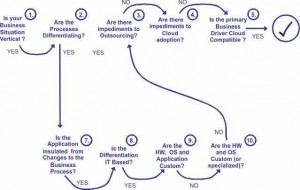
The business process is a key differentiator for the business, and the differentiation is IT-based, so PaaS or IaaS may fit. Konsort-Prinz has standard hardware and operating system, and a custom stock management application, so SaaS is unlikely to meet its needs for stock management, but could be considered for other applications, such as accounting and human resources.
Konsort-Prinz decides to go for public cloud because its primary aim is to allow for large variations in processing load. With private cloud, it would have to invest in sufficient capacity to meet peak seasonal demand, and this would be unused for most of the year. A hybrid cloud, with enough capacity to meet minimum demand in-house might be a possibility, but the application architecture is not suitable for multi-site processing.
The company has established its vision: “We will cope better with peak business demand by deploying our applications software on cloud computing platforms.”
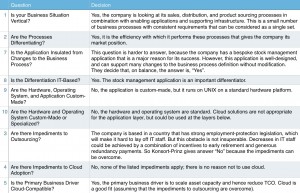
Sam Pan Engineering
This engineering conglomerate has a different vision. Each of its subsidiary companies has a different IT solution for the same problem. It has a large number of small, but still under-utilized systems, each requiring specialist support. It sees an opportunity to streamline its operations by offering its subsidiaries capacity on better-utilized, more cost-effective systems, by reducing its support burden, and by rationalizing processes through use of common software. Cloud computing could be the means to achieve this.
This company’s path through the decision tree is rather simpler.

Its responses to the questions are shown in the table.
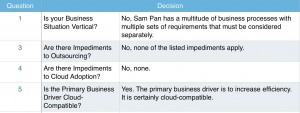
Again, the solution considerations indicate that all forms of cloud computing should be considered.
Sam Pan Engineering does not have large variations in workload, and sees regular use of public cloud services as being very expensive. Investment in capacity to support a private cloud looks much more attractive financially. It decides to implement a private cloud, and then to place standard applications on its cloud platform and offer them as SaaS to its constituent companies and departments.
It has established a different vision: “We will reduce costs and streamline our business processes by offering standard software applications on a private cloud.”
ViWi
This company has an opportunity to make money from a radically new product. Cloud computing seems to provide an excellent environment for development and launch. It uses the decision tree to validate this. It takes the same path through the tree as Sam Pan Engineering. Its responses are shown in the table.
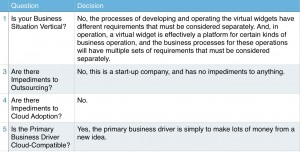
Again, all forms of cloud computing should be considered. ViWi goes for public cloud to support its development because this means that it can avoid capital expenditure in the start-up phase. PaaS, or IaaS plus a standard platform, will give the development facilities that it needs. When the product is launched, it will use the same cloud service for the run-time environment. Again, this will mean that it avoids heavy capital expenditure before there are significant revenues to justify it. If the product takes off as hoped, it may invest in some in-house capacity to give a better return.
ViWi’s architecture vision is: “We will develop and launch a new product without the need for major investment in supporting IT by using cloud services.”
